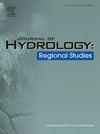Effects of long-term meteorological trends on streamflow in the Northern Murray-Darling Basin (MDB), Australia 1981–2020
IF 4.7
2区 地球科学
Q1 WATER RESOURCES
引用次数: 0
Abstract
Study region
The Northern Murray-Darling Basin, Australia.
Study focus
We estimated the impacts of meteorological trends on streamflow over a 40-year period for seven catchments in the Northern Murray-Darling Basin (NMDB), Australia.
New hydrological insights for the region
We found that meteorological trends over the 1981–2020 period explain all the streamflow decline in catchments with little or no irrigation withdrawals, whereas in catchments with substantial irrigation water withdrawals meteorological trends explained only about half the observed decline in streamflow. If the increase in water withdrawals for irrigation over the 2006–2020 period relative to 1981–2000 had, instead, been reallocated to mitigate declines in streamflow over the 1981–2000 period, the average annual gross value of irrigated agriculture (GVIA) in the NMDB would have been reduced by 9–14 %. If a water reallocation over the 2006–2020 period had been undertaken to maintain the same mean ratio of irrigation water withdrawals to streamflow over the 1980–2000 period, GVIA would have declined by 19–29 %. Our results highlight the importance of quantifying and partitioning the effects of long-term meteorological trends on streamflow in semi-arid and arid environments to improve water planning and allocation.
求助全文
约1分钟内获得全文
求助全文
来源期刊

Journal of Hydrology-Regional Studies
Earth and Planetary Sciences-Earth and Planetary Sciences (miscellaneous)
CiteScore
6.70
自引率
8.50%
发文量
284
审稿时长
60 days
期刊介绍:
Journal of Hydrology: Regional Studies publishes original research papers enhancing the science of hydrology and aiming at region-specific problems, past and future conditions, analysis, review and solutions. The journal particularly welcomes research papers that deliver new insights into region-specific hydrological processes and responses to changing conditions, as well as contributions that incorporate interdisciplinarity and translational science.
 求助内容:
求助内容: 应助结果提醒方式:
应助结果提醒方式:


